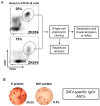Pre-Existing Dengue Immunity Drives a DENV-Biased Plasmablast Response in ZIKV-Infected Patient
- PMID: 30597938
- PMCID: PMC6356269
- DOI: 10.3390/v11010019
Pre-Existing Dengue Immunity Drives a DENV-Biased Plasmablast Response in ZIKV-Infected Patient
Abstract
The re-emergence of Zika virus (ZIKV) in the western hemisphere has most significantly affected dengue virus (DENV) endemic regions. Due to the geographical overlap between these two closely related flaviviruses, numerous individuals who suffered ZIKV infection during recent outbreaks may have also previously been exposed to DENV. As such, the impact of pre-existing dengue immunity on immune responses to ZIKV has been an area of focused research and interest. To understand how B cell responses to a ZIKV infection may be modulated by prior dengue exposures, we compared and contrasted plasmablast repertoire and specificity between two ZIKV-infected individuals, one dengue-naïve (ZK018) and the other dengue-experienced (ZK016). In addition to examining serological responses, we generated 59 patient plasmablast-derived monoclonal antibodies (mAbs) to define the heterogeneity of the early B cell response to ZIKV. Both donors experienced robust ZIKV-induced plasmablast expansions early after infection, with comparable mutational frequencies in their antibody variable genes. However, notable differences were observed in plasmablast clonality and functional reactivity. Plasmablasts from the dengue-experienced donor ZK016 included cells with shared clonal origin, while ZK018 mAbs were entirely clonally unrelated. Both at the mAb and plasma level, ZK016 antibodies displayed extensive cross-reactivity to DENV1-4, and preferentially neutralized DENV compared to ZIKV. In contrast, the neutralization activity of ZK018 mAbs was primarily directed towards ZIKV, and fewer mAbs from this donor were cross-reactive, with the cross-reactive phenotype largely limited to fusion loop-specific mAbs. ZK016 antibodies caused greater enhancement of DENV2 infection of FcRγ-expressing cells overall compared to ZK018, with a striking difference at the plasma level. Taken together, these data strongly suggest that the breadth and protective capacity of the initial antibody responses after ZIKV infection may depend on the dengue immune status of the individual. These findings have implications for vaccine design, given the likelihood that future epidemics will involve both dengue-experienced and naïve populations.
Keywords: B-cell; DENV; ZIKV; antibodies; cross-reactivity; plasmablast.
Conflict of interest statement
N.R. has received funds from Merck, Pfizer and Sanofi Pasteur for research activities unrelated to this work. All authors declare no conflict of interest.
Figures







Similar articles
-
B Cell Responses during Secondary Dengue Virus Infection Are Dominated by Highly Cross-Reactive, Memory-Derived Plasmablasts.J Virol. 2016 May 27;90(12):5574-85. doi: 10.1128/JVI.03203-15. Print 2016 Jun 15. J Virol. 2016. PMID: 27030262 Free PMC article.
-
Prior dengue virus serotype 3 infection modulates subsequent plasmablast responses to Zika virus infection in rhesus macaques.mBio. 2024 Mar 13;15(3):e0316023. doi: 10.1128/mbio.03160-23. Epub 2024 Feb 13. mBio. 2024. PMID: 38349142 Free PMC article.
-
Multiplexed FluoroSpot for the Analysis of Dengue Virus- and Zika Virus-Specific and Cross-Reactive Memory B Cells.J Immunol. 2018 Dec 15;201(12):3804-3814. doi: 10.4049/jimmunol.1800892. Epub 2018 Nov 9. J Immunol. 2018. PMID: 30413671 Free PMC article.
-
Modulation of Dengue/Zika Virus Pathogenicity by Antibody-Dependent Enhancement and Strategies to Protect Against Enhancement in Zika Virus Infection.Front Immunol. 2018 Apr 23;9:597. doi: 10.3389/fimmu.2018.00597. eCollection 2018. Front Immunol. 2018. PMID: 29740424 Free PMC article. Review.
-
Humoral cross-reactivity between Zika and dengue viruses: implications for protection and pathology.Emerg Microbes Infect. 2017 May 10;6(5):e33. doi: 10.1038/emi.2017.42. Emerg Microbes Infect. 2017. PMID: 28487557 Free PMC article. Review.
Cited by
-
Affinity Tag Coating Enables Reliable Detection of Antigen-Specific B Cells in Immunospot Assays.Cells. 2021 Jul 21;10(8):1843. doi: 10.3390/cells10081843. Cells. 2021. PMID: 34440612 Free PMC article.
-
Dengue and Zika virus infections in children elicit cross-reactive protective and enhancing antibodies that persist long term.Sci Transl Med. 2021 Oct 6;13(614):eabg9478. doi: 10.1126/scitranslmed.abg9478. Epub 2021 Oct 6. Sci Transl Med. 2021. PMID: 34613812 Free PMC article.
-
Protective and enhancing interactions among dengue viruses 1-4 and Zika virus.Curr Opin Virol. 2020 Aug;43:59-70. doi: 10.1016/j.coviro.2020.08.006. Epub 2020 Sep 24. Curr Opin Virol. 2020. PMID: 32979816 Free PMC article. Review.
-
Pattern of circulating SARS-CoV-2-specific antibody-secreting and memory B-cell generation in patients with acute COVID-19.Clin Transl Immunology. 2021 Jan 31;10(2):e1245. doi: 10.1002/cti2.1245. eCollection 2021. Clin Transl Immunology. 2021. PMID: 33552508 Free PMC article.
-
Identification of immunodominant T cell epitopes induced by natural Zika virus infection.Front Immunol. 2023 Aug 29;14:1247876. doi: 10.3389/fimmu.2023.1247876. eCollection 2023. Front Immunol. 2023. PMID: 37705976 Free PMC article.
References
-
- Styczynski A.R., Malta J., Krow-Lucal E.R., Percio J., Nobrega M.E., Vargas A., Lanzieri T.M., Leite P.L., Staples J.E., Fischer M.X., et al. Increased rates of Guillain-Barre syndrome associated with Zika virus outbreak in the Salvador metropolitan area, Brazil. PLoS Negl. Trop. Dis. 2017;11:e0005869. doi: 10.1371/journal.pntd.0005869. - DOI - PMC - PubMed
Publication types
MeSH terms
Substances
Grants and funding
LinkOut - more resources
Full Text Sources
Other Literature Sources
Medical
Research Materials

